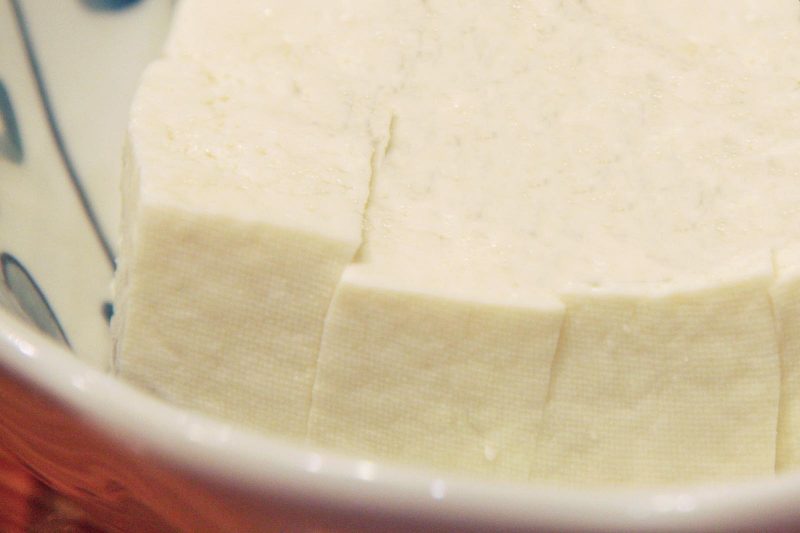Shima dofu
What is Shima-dofu?

Shima dofu
Shimadofu (island tofu) is a type of tofu produced mainly in Okinawa Prefecture. Also called Okinawan tofu and Uchina tofu. It is an essential ingredient in chanpuru dishes such as goya chanpuru (bitter melon stir-fry), a typical local and home-style dish of Okinawa, and is also often served in miso soup. Traditionally made using sea salt instead of bittern, it is characterised by its salty taste, firmness and texture.
Some types of tofu are now produced using bittern, which are somewhat different from the traditional Okinawan ‘Shimadofu’.
Soya beans soaked in water overnight are placed in a bean scrubber to make ‘Go / Gojiru’, which is then separated into soya milk and okara before the beans are cooked using the ‘raw squeezing method’ (outside Okinawa, this method is generally called the ‘cooked squeezing method’ and is often used to separate soya milk and okara after cooking the beans). (This is said to be a highly nutritious method.)
The soya milk is then cooked for an hour and seawater (mars (sea salt) or bittern) is added to it.
It is then placed in a moulded box lined with cloth, weighed down and allowed to drain and harden.
The process is repeated three or four times to produce firm Shima dofu with a stuffy inside. The fluffy tofu before it hardens is called ‘yushi-dofu’, which becomes Shima dofu when it is placed in the mould, drained and hardened.
In the past, freshly made, warm Shima dofu was sold.
Even today, warm Shima dofu is sold in bags at shops and other outlets and is known as ‘achikoko-dofu’ (‘hot tofu’ in the Okinawan dialect).

Yushi-dofu, which is the state of shima-dofu before it is placed in a mould and hardened.
History of Shima tofu
In the Kingdom of the Ryukyus, where trade with China was active and people and goods came and went in great numbers, tofu is said to have been produced using a production method that was imported from China from ancient times.
One theory is that this method was introduced around the 14th century, when the same ‘fresh-squeezed’ production method as in China was introduced to Okinawa, and so the fresh-squeezed type is still common in Okinawa today. During the Ryukyu Dynasty, it was treated as a gift, but it eventually became a common food for the general public.
Characteristics of Shima dofu
Shima dofu is characterised by its firmness compared to tofu commonly found in other regions, and its weight and size, ranging from 900g to 1kg per tofu chop, are also characteristics of Shima dofu. Okinawa has a subtropical climate with hot temperatures, so tofu with a high water content usually damages quickly and does not last long, but by removing the water content thoroughly, it can be preserved well, making it suitable for Okinawa’s climate.
Usage of Shima dofu
Shima dofu is generally cooked and often used in dishes, especially as champuru. It is also boiled and used as an ingredient in miso soup, and is often served in izakaya (Japanese-style pubs) as skugarasu tofu with skugarasu on top. Tofu Yo, known as one of the traditional fermented foods of Okinawa, is made by fermenting and maturing Shima dofu with red yeast, rice malt and awamori.

Tofuyo
 Fish miso soup with Shima dofu (meibai soup)
Fish miso soup with Shima dofu (meibai soup)
















